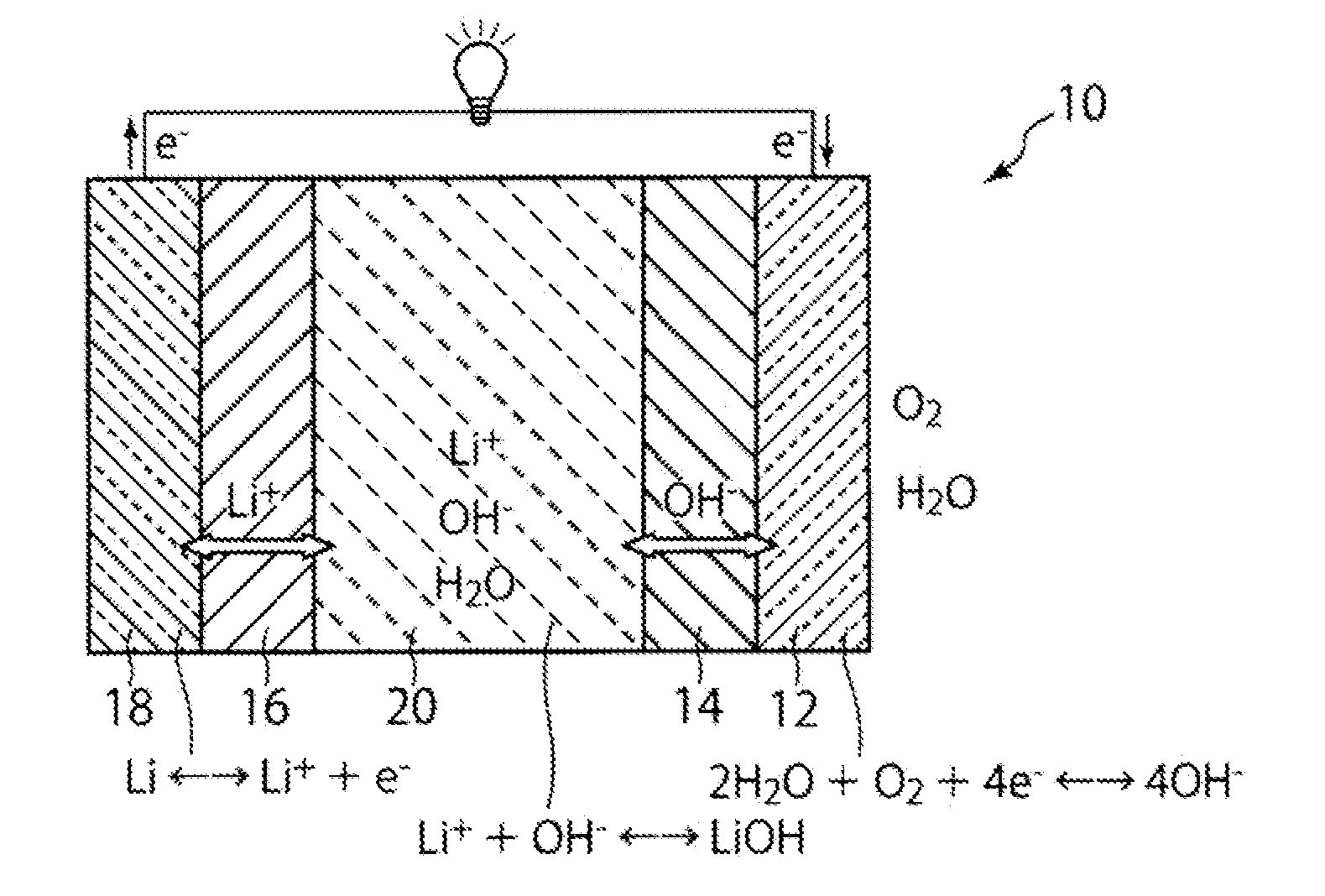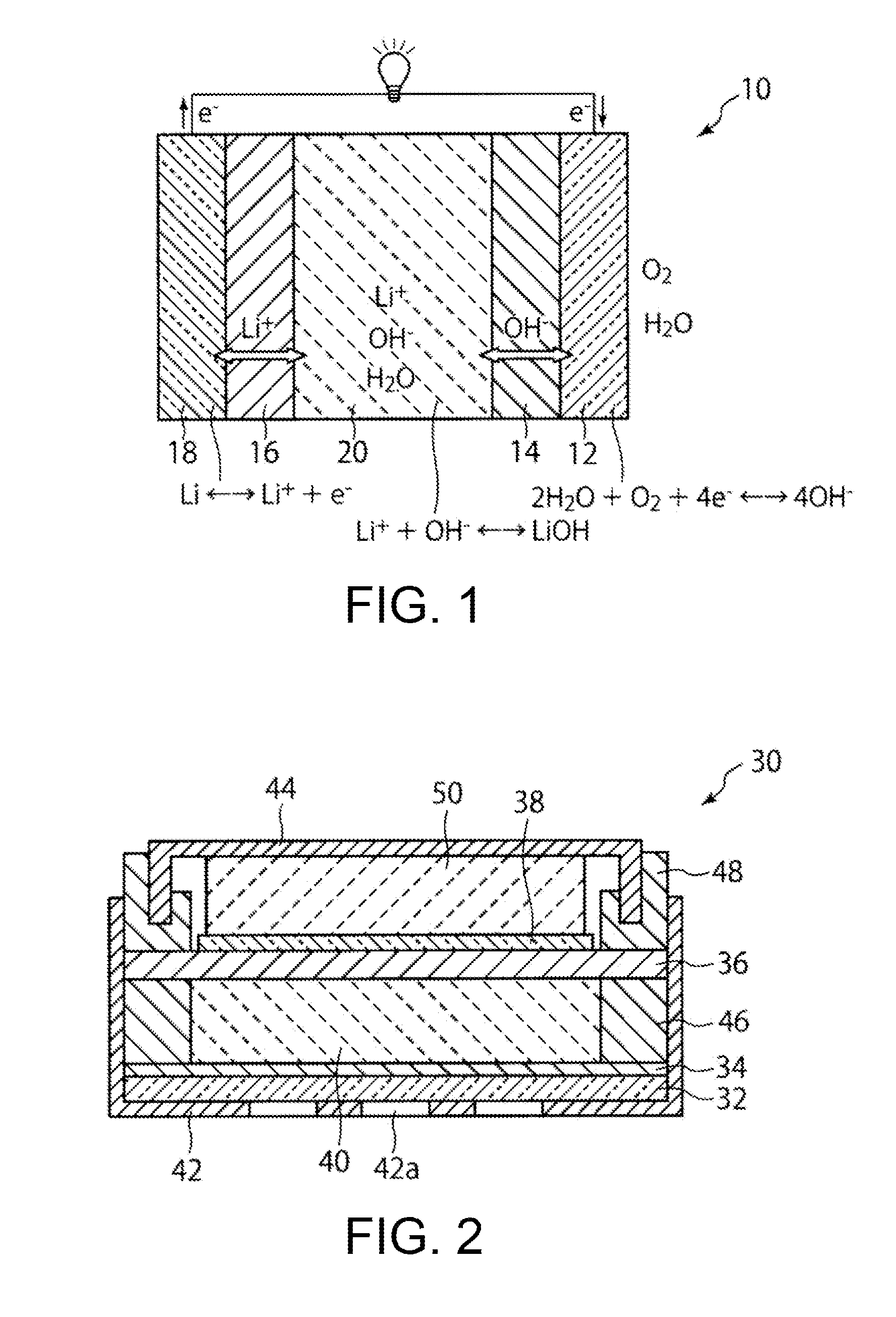Lithium air secondary battery
a secondary battery and lithium air technology, applied in secondary cells, fuel and secondary cells, inorganic chemistry, etc., can solve the problems of deterioration of air electrode performance, suitable for long-term use, and deterioration of electrolytic solution, so as to prevent the deterioration of alkaline electrolytic solution
- Summary
- Abstract
- Description
- Claims
- Application Information
AI Technical Summary
Benefits of technology
Problems solved by technology
Method used
Image
Examples
example 1
Preparation of Anion Exchanger Composed of Hydroxide-Ion Conductive Inorganic Solid Electrolyte
[0066]A mixed aqueous solution containing Mg(NO3)2 and Al(NO3)3 was prepared in a way such that a molar ratio of Mg / Al was 3 / 1. This mixed aqueous solution was added to an aqueous Na2CO3 solution dropwise to give precipitates. At this time, a sodium hydroxide solution was added to control the solution pH to a constant level of about 10. The resulting precipitates were filtered, washed, and dried to obtain a layered double hydroxide powder having an average primary particle diameter of 0.5 μm or less and an average secondary particle diameter of 5 μm or less. This layered double hydroxide powder was pressed by a uniaxial pressing method to give a plate-like green compact. Pure water and the plate-like green compact were placed in a pressure vessel and heated at 150° C. for 4 hours to give a plate-like inorganic solid electrolyte body as an anion exchanger. The resulting inorganic solid elec...
example 2
Preparation of Separator Composed of Lithium-Ion Conductive Inorganic Solid Electrolyte
[0067]As raw material components for preparation of raw materials for firing, lithium hydroxide (Kanto Chemical Co., Inc.), lanthanum hydroxide (Shin-Etsu Chemical Co., Ltd.), zirconium oxide (Tosoh Corporation), and tantalum oxide were provided. These powders were weighed and blended so as to give LiOH:La(OH)3:ZrO2:Ta2O5=7:3:1.625:0.1875 and mixed in a grinding mill to give raw materials for firing.
[0068]As a first firing step, the raw materials for firing was placed in an alumina crucible, heated in air with a temperature ramp rate of 600° C. / hour, and kept at 900° C. for 6 hours.
[0069]As a second firing step, γ-Al2O3 and / or magnesium oxide was added to the powder obtained in the first firing step such that the Al concentration was 0.16 wt %, and the resulting powder was mixed with grinding ball and pulverized for 3 hours using a vibration mill. After the resulting pulverized powder was sieved, ...
example 3
Preparation of Lithium-Air Secondary Battery
[0071]A lithium-air secondary battery 30 as shown in FIG. 2 is assembled using the anion exchanger prepared in Example 1 and the separator prepared in Example 2. First, a circular stainless steel positive electrode case 42 having air holes 42a is provided. An air electrode 32 composed of a positive electrode current collector made from stainless steel wire gauze to which platinum-supported carbon has been applied, and the anion exchanger 34 prepared in Example 1, are stacked at the bottom of the positive electrode case 42. An insulating positive electrode gasket 46 made of nylon is placed along the inner circumferential edge of the positive electrode case 42 so as to tightly contact with the outer edge of the anion exchanger. Next, the positive electrode case 42 is filled with a discharge product-containing electrolytic solution 40 in which a lithium hydroxide monohydrate powder and a saturated aqueous lithium hydroxide solution are mixed....
PUM
| Property | Measurement | Unit |
|---|---|---|
| Fraction | aaaaa | aaaaa |
| Composition | aaaaa | aaaaa |
| Density | aaaaa | aaaaa |
Abstract
Description
Claims
Application Information
 Login to View More
Login to View More - R&D
- Intellectual Property
- Life Sciences
- Materials
- Tech Scout
- Unparalleled Data Quality
- Higher Quality Content
- 60% Fewer Hallucinations
Browse by: Latest US Patents, China's latest patents, Technical Efficacy Thesaurus, Application Domain, Technology Topic, Popular Technical Reports.
© 2025 PatSnap. All rights reserved.Legal|Privacy policy|Modern Slavery Act Transparency Statement|Sitemap|About US| Contact US: help@patsnap.com


